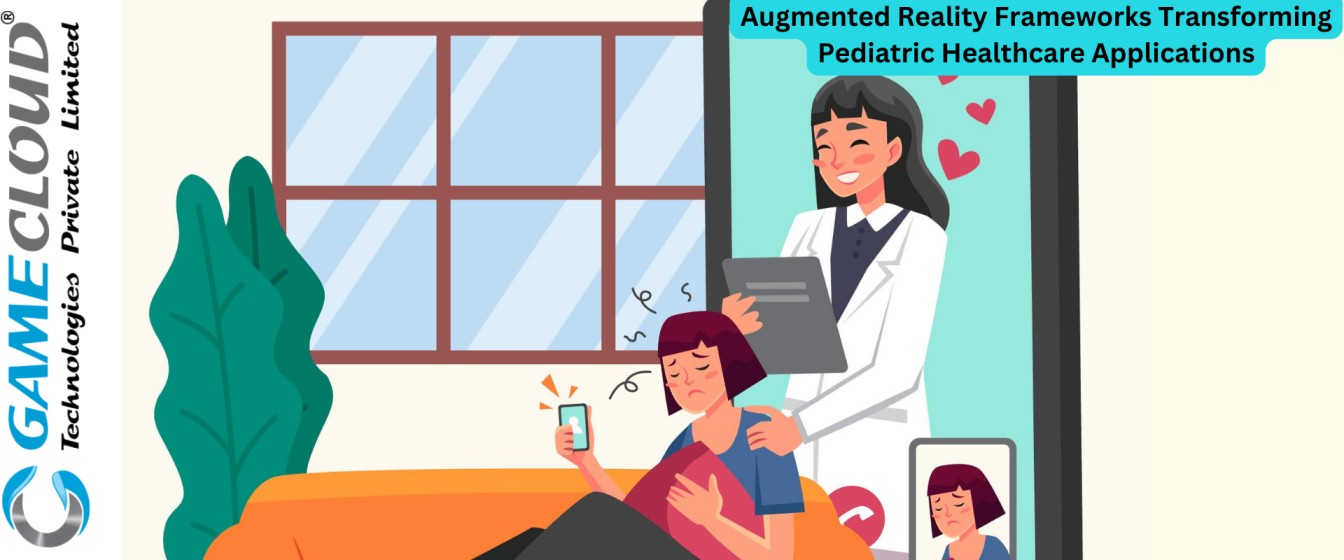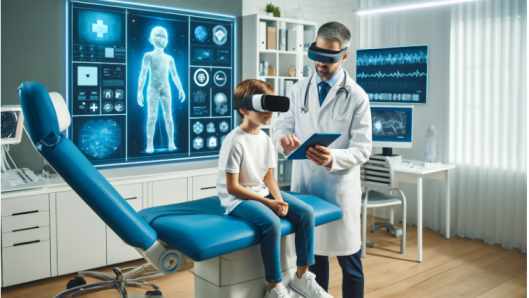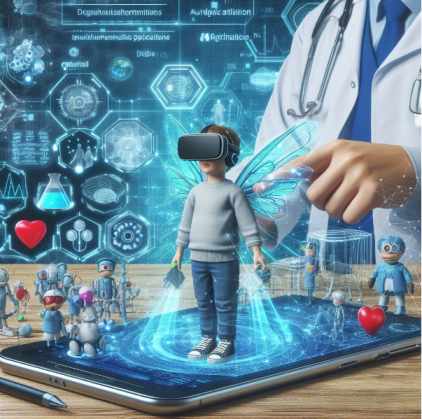
Augmented reality (AR) has emerged as a transformative technology in pediatric healthcare, offering a wide array of benefits that revolutionize patient care and medical practices. By integrating computer-generated information with the physical world, AR provides a unique platform for enhancing patient engagement, improving medical procedures, and fostering a more interactive healthcare experience for children.
In pediatric healthcare, where effective communication and patient understanding are paramount, AR plays a crucial role in visualizing complex medical concepts and anatomical structures in a more immersive and understandable manner. Through AR applications, patients and their families can explore virtual representations of their bodies, facilitating a deeper understanding of medical conditions, treatment options, and procedures.
One of the key advantages of AR in pediatric healthcare is its ability to enhance patient education and empowerment. Traditional methods of patient education often fall short in capturing a child’s attention or effectively conveying complex medical information. AR addresses this challenge by providing an interactive and visually engaging platform that educates children and their parents about medical conditions, treatment outcomes, and disease processes in a more engaging and personalized way.
Moreover, AR frameworks in pediatric healthcare not only improve diagnostic capabilities by aiding in identifying abnormalities and visualizing complex anatomical structures but also enhance surgical procedures by providing real-time guidance to surgeons during complex surgeries. This technology enables increased precision, accuracy, and efficiency in medical interventions, ultimately leading to better surgical outcomes and patient care.
Current Landscape of AR in Pediatric Healthcare
The current landscape of augmented reality (AR) in pediatric healthcare showcases its transformative impact on medical training, patient education, and procedural skills development. AR frameworks like ARCore and Microsoft HoloLens are at the forefront of this revolution, offering innovative solutions that enhance pediatric healthcare practices.
- AR in Medical Training
AR is revolutionizing the way pediatric medical professionals are trained. By integrating computer-generated information with real-world environments, AR enables trainees to explore virtual anatomical models, practice complex procedures, and engage in interactive simulations. This technology allows for standardized, high-quality training programs that can be accessed conveniently by students, interns, and nurses.
- AR in Patient Education
One of the most significant advantages of AR in pediatric healthcare is its ability to enhance patient education and empowerment. Traditional methods of patient education often fall short in capturing a child’s attention or effectively conveying complex medical information. AR addresses this challenge by providing an interactive and visually engaging platform that educates children and their parents about medical conditions, treatment options, and procedures.

Through AR applications, patients and their families can visualize anatomical structures, disease processes, and treatment outcomes in a more immersive and understandable manner. This personalized approach to patient education fosters a deeper understanding of medical conditions, reduces anxiety, and empowers children to actively participate in their healthcare journey.
- AR in Procedural Skills Development
AR frameworks like ARCore and Microsoft HoloLens are transforming pediatric healthcare practices by enhancing procedural skills development. During complex surgeries, AR can provide surgeons with real-time guidance, overlaying vital information such as anatomical structures or the location of critical blood vessels directly onto the patient’s body.
This visualization technique allows for increased precision and accuracy, reducing the risk of complications and enhancing surgical outcomes. Moreover, AR-assisted surgical procedures can improve surgical training and education, enabling trainee surgeons to learn and practice complex procedures in a simulated environment before performing them on real patients.
The current landscape of AR in pediatric healthcare showcases its vast potential to revolutionize medical training, patient education, and procedural skills development. As AR frameworks continue to evolve and become more accessible, we can expect to see even greater advancements in the field of pediatric healthcare, ultimately leading to improved patient outcomes and a more engaging, interactive healthcare experience for young patients.
AR Frameworks for Pediatric Healthcare Games
AR frameworks like ARCore and Microsoft HoloLens enable developers to create games that encourage physical activity and improve patient engagement. These frameworks utilize advanced technologies such as automatic surface detection, which allows games to be played without any previous configuration
By leveraging AR, developers can create games that overlay virtual objects and characters onto the patient’s surroundings, making the gaming experience more engaging and interactive. This approach helps to motivate pediatric patients to participate in physical activities, as they are immersed in a visually appealing and entertaining environment.
Collaborative AR Frameworks
Collaborative AR frameworks enable multiple players to engage in the same AR experience simultaneously. These frameworks provide functionalities for connecting AR devices, allowing children to interact and collaborate with each other while sharing the same virtual content.
The collaborative nature of these frameworks enhances the social aspect of gaming, encouraging pediatric patients to engage with their peers and healthcare providers in a fun and interactive way. This shared experience can foster a sense of community, reduce feelings of isolation, and improve overall well-being.
Moreover, collaborative AR frameworks enable real-time interaction with virtual objects. Patients can manipulate and control these objects using their own movements and gestures, creating a more immersive and engaging gaming experience. This real-time interaction helps to keep patients engaged and motivated throughout the gaming session.
By using AR frameworks, developers can create games that are tailored to the specific needs and preferences of pediatric patients. These games can be designed to target various aspects of healthcare, such as physical rehabilitation, pain management, and mental well-being.

Transformative Impact of AR on Pediatric Healthcare
Augmented reality (AR) frameworks are revolutionizing pediatric healthcare by providing innovative solutions for teaching, training, and monitoring applications. These transformative technologies are not only enhancing the quality of care but also improving patient outcomes and engagement.
- AR in Teaching and Training:
AR is transforming the way pediatric healthcare professionals are trained and educated. By integrating computer-generated information with real-world environments, AR enables trainees to explore virtual anatomical models, practice complex procedures, and engage in interactive simulations. This technology allows for standardized, high-quality training programs that can be accessed conveniently by students, interns, and nurses.
One study found that an AR application developed for pediatric first aid training had a positive effect on the knowledge and skill levels of nursing students. The AR application significantly improved the students’ self-confidence and first aid skills compared to traditional training methods.
- AR in Patient Monitoring and Engagement:
AR frameworks are also revolutionizing patient monitoring and engagement in pediatric healthcare. By overlaying digital information onto the real world, AR tools have transformed the way children interact with healthcare professionals, perceive medical procedures, and engage with their treatment plans.
AR applications like interactive games and educational tools turn daunting hospital visits into engaging and informative experiences. For instance, an AR app that explains surgical procedures through a child-friendly narrative can significantly reduce preoperative anxiety.
Moreover, AR helps children grasp their health conditions better, leading to improved adherence to treatment. This is evident in AR-assisted physiotherapy sessions where animated cues encourage correct movement patterns, motivating children to engage in their rehabilitation process.
- Practical Use Cases of AR in Pediatric Healthcare:
One practical use case of AR in pediatric healthcare is the use of an AR application for pediatric code cart training. The study found that mobile-based AR training can provide familiarity with low-frequency and high-risk equipment and its location, optimizing speed and efficiency during emergencies.
Another example is the use of AR to distract children during painful procedures like injections or blood tests. By overlaying captivating visuals or interactive games onto the real-world setting, AR reduces stress and enhances cooperation between healthcare providers and their young patients.
Future Trends in AR for Pediatric Healthcare
Future Trends and Predictions in AR for Pediatric Healthcare are promising, with advancements in AR technology, increased adoption of AR-based solutions, and the integration of AI for personalized patient experiences on the horizon. The potential of AR frameworks to further enhance pediatric healthcare outcomes is vast, encompassing areas such as remote patient monitoring, data visualization, and improved patient-provider interactions.

Future Trends in AR for Pediatric Healthcare
- Advancements in AR Technology: The future of AR in pediatric healthcare will see continuous advancements in technology, leading to more sophisticated and immersive AR experiences for young patients. This includes improved graphics, enhanced interactivity, and seamless integration with medical procedures.
- Increased Adoption of AR-Based Solution: As AR technology becomes more accessible and cost-effective, there will be a surge in the adoption of AR-based solutions in pediatric healthcare settings. Hospitals and clinics will leverage AR applications for patient education, procedural guidance, and rehabilitation programs.
- Integration of AI for Personalized Patient Experiences: The integration of artificial intelligence (AI) with AR frameworks will enable personalized patient experiences in pediatric healthcare. AI algorithms can analyze patient data, preferences, and medical history to tailor AR applications to individual needs, enhancing engagement and treatment outcomes.
Potential Enhancements in Pediatric Healthcare Outcomes
- Remote Patient Monitoring: AR frameworks will enable remote patient monitoring, allowing healthcare providers to track pediatric patients’ progress, vital signs, and adherence to treatment plans from a distance. This real-time data collection will facilitate proactive interventions and personalized care.
- Data Visualization: AR technology will revolutionize data visualization in pediatric healthcare, providing healthcare professionals with intuitive and interactive tools to analyze complex medical data. Visual representations of patient information, medical images, and treatment outcomes will enhance decision-making and communication among care teams.
- Improved Patient-Provider Interactions: AR frameworks will facilitate improved patient-provider interactions by enhancing communication, fostering empathy, and promoting shared decision-making. Healthcare providers can use AR applications to explain medical conditions, treatment options, and procedures in a more engaging and understandable manner, leading to increased patient satisfaction and compliance.
The future of AR in pediatric healthcare holds great promise, with advancements in technology, increased adoption of AR-based solutions, and the integration of AI for personalized patient experiences. The potential of AR frameworks to enhance pediatric healthcare outcomes through remote patient monitoring, data visualization, and improved patient-provider interactions signifies a transformative shift towards more effective and patient-centered care for young patients.
Real-Life Examples of AR Transforming Pediatric Healthcare
- BioFlightVR: BioFlightVR is an AR platform that allows medical professionals to visualize and interact with 3D anatomical models. In pediatric healthcare, BioFlightVR has been used for medical training, enabling trainees to explore virtual anatomical models of children and practice complex procedures in a simulated environment.
- MedicalRealities: MedicalRealities is an AR platform that provides interactive surgical training for medical professionals. The platform includes a library of pediatric surgical procedures, allowing trainees to practice in a safe and controlled environment before performing on real patients. This helps improve surgical outcomes and reduce complications in pediatric patients.
- AccuVein: AccuVein is an AR device that helps healthcare providers locate veins more easily, particularly in children. By projecting a map of the patient’s vasculature directly onto their skin, AccuVein reduces the number of needle sticks and improves the success rate of intravenous (IV) insertions. This technology has been particularly beneficial in pediatric patients, who often have smaller and more difficult-to-access veins.
- Orca Health: Orca Health is an AR platform that provides patient education and engagement tools. The platform includes interactive 3D models of the human body, allowing patients and their families to visualize medical conditions and treatment options in a more engaging and understandable manner. In pediatric healthcare, Orca Health has been used to reduce anxiety and improve adherence to treatment plans by educating children about their conditions and the importance of following their treatment regimens.
- EchoPixel: EchoPixel is an AR platform that enhances diagnostic imaging by allowing healthcare providers to interact with and manipulate 3D medical images. In pediatric healthcare, EchoPixel has been used to improve the accuracy of diagnoses by providing a more detailed and interactive view of complex anatomical structures. This technology has been particularly beneficial in cases where traditional imaging techniques may not provide a clear picture of the patient’s condition.
GamerThrong and QualityReality at the Forefront of Innovations
QualityReality, a sub-brand of GameCloud Technologies Pvt Ltd, is a leading player in the XR and Metaverse Services sector. Since its establishment, GameCloud Technologies has been setting benchmarks in gaming and IT services, evolving to meet industry demands. The company introduced QualityReality, a division specializing in XR & Metaverse Services, with a team of experts dedicated to pioneering Extended Reality solutions and offering comprehensive testing and development on XR platforms.
QualityReality’s commitment to excellence in the XR and Metaverse sector is evident in its mission to help developers deliver the best possible products to their users. The company’s team of certified QA testers, experienced engineers, and technology reviewers are dedicated to helping clients deliver high-quality XR and Metaverse experiences.
GamerThrong, another sub-brand of GameCloud Technologies, leverages augmented reality (AR) frameworks to transform pediatric healthcare applications, particularly in the realm of game development. By tapping into a global network of gamers, tech enthusiasts, and VR aficionados, GamerThrong creates a collaborative platform that ensures constant gameplay innovation and a robust server operations network through its 24/7 LiveOps Support.
Conclusion
In conclusion, the exploration of augmented reality (AR) frameworks in pediatric healthcare applications reveals a transformative impact on patient care and medical outcomes. AR technology has ushered in a new era in pediatric healthcare, offering innovative solutions that cater to the unique needs of young patients. By overlaying digital information onto the real world, AR tools have revolutionized the way children interact with healthcare professionals, perceive medical procedures, and engage with their treatment plans.
